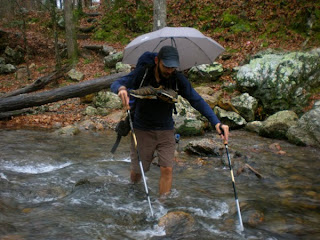
Recently, I did a talk for the Louisiana Hiking Club on one of the most problematic things outdoors people face in their journeys. Wet weather. And I mean day after day wet weather that can start to saturate even the most careful packer. I’ve decided to share some of these ideas via my blog. This will be done in a number of installments (the talk lasted 1.5 hours). Our first installment will focus on packing systems.
 Location and Priority of Accessibility
Location and Priority of Accessibility
A major key to keeping your gear dry is where your gear is loaded in your pack or boat. I like to think of my packing in 3 levels of accessibility. Level 1 is all the things I could need to get to without taking my pack off or beaching my boat. These items should be in areas that are easily reached while walking down the trail or paddling. These items include:
Water
Snacks
Rain Jacket (Pants are level 2)
Pack Cover
Navigation (Map, Compass, GPS)
Water Purification (Filter, Chemical Treatment, Steri Pen)
Stove Fuel (I keep this outside not for convenience – but rather to prevent leakage inside my pack)
Camera
Level 2 items are things that you may need during the day and can access without removing the raincover from your pack. These items include:
Rain Pants, Hat & Gloves
First Aid Kit (Note that a blister kit could be level 1 if you are not sure of your boots or you are leading an inexperienced group)
Lunch for the day
Day Shelter (Bothy, Tarp, or Fast-Pitch portion of your tent system)
Level 3 items include everything else. These items are generally things you will need once you set up camp (spare clothes, sleeping bag and pad, tent body, flashlight etc…)
Pack Liners and Pack Covers
Pack covers are essential for keeping your pack dry. Think of it as a rain jacket for your pack. All packs leak at the seams and zippers – so a pack cover is absolutely essential. An alternative is a Pack Liner. This is a lightweight drybag that goes inside your pack. This system is utilized by hikers in wet climates like Scotland and proven to be superior to Pack Covers in keeping gear dry. All dry gear goes in your pack liner with damp things above it. Or – get 2 pack liners and use one for damp items and one for dry items. Many thru hikers utilize a very simple pack made with fabrics and foams that will not absorb any (or much) water. They rely on their pack liners and don’t worry about bringing a pack cover.
Rainwear
Obviously, good raingear is essential for wet weather outdoor use. My preference is for a rainsuit (jacket and pants) as opposed to a poncho. Your rainsuit becomes your outer  layer blocking not only rain, but cold and wind as well. It provides the most protection.
layer blocking not only rain, but cold and wind as well. It provides the most protection.
What you want to look for in a rain jacket is a high quality waterproof / breathable material that does not utilize a nylon or mesh lining on the inside. These linings add weight and become saturated with sweat anyway. The jacket should have taped seams and covers over every zipper. The hood should have a nice large bill on it to keep water from running down your face. A good suggestion is to bring a quick dry ball cap to wear not only for sun but also under your rain hood to help out with the problem of water running down your face.
I always recommend a very light base layer such as Patagonia Capilene 2 underwear to wear under your rain jacket. This spreads perspiration allowing it to vent out of the jacket quickly and easily. It also stops body oils from getting into the waterproof breathable coating inside the jacket. Even in warm weather – you WILL be more comfortable with a light longsleeve shirt on under your raingear.
Keeping your raingear in good shape is absolutely essential. EVERY waterproof breathable jacket – no matter the price needs to have the outer Durable Water Repellancy revived from time to time. This DWR allows water to bead and roll off keeping the nylon  from saturating – allowing the jacket to breathe much better. To do this, we recommend a product called Revivex. It is applied while the jacket is wet after washing. You then “Set” the DWR into the jacket by running it through a warm dryer. Anytime your jacket isn’t beading water anymore – it’s time to Revivex it.
from saturating – allowing the jacket to breathe much better. To do this, we recommend a product called Revivex. It is applied while the jacket is wet after washing. You then “Set” the DWR into the jacket by running it through a warm dryer. Anytime your jacket isn’t beading water anymore – it’s time to Revivex it.
Hiking in raingear in warm humid weather is a challenge. For this I recommend an Umbrella. The umbrella can be affixed to your pack strap easily allowing your hands to be free for trekking poles. Click here to view how to set this up. If you like to take it to the extreme in lightness try a rain kilt instead of pants. Not only are they more ventilated and cooler – but you look at least 30% more tough (or maybe goofy).
Remember – it’s not about looking cool. It’s all about going light, being efficient with your gear and enjoying your experience in the outdoors.

